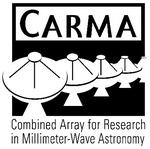

 |
 |
Alberto Bolatto's Research
 |
I am a professor at the Department of Astronomy of the University of Maryland, and part of the Laboratory for Millimeter-wave Astronomy (LMA). My main research focuses on galaxies, and I use ground and space facilities to study the effects of heavy element abundance on the physics of the interstellar medium, the relationship between gas, dust, and star formation, and the properties of dark matter galaxy halos. My interest is to understand the process of structure creation in the Universe, using nearby objects as laboratories in which to develop and test ideas. There are student involvement opportunities available in these and other ongoing projects. |
|
THE CARMA STING |
|
|
|
The Magellanic Clouds I lead S3MC and S4MC, two surveys of the Small Magellanic Cloud that use the Spitzer Space Telescope to study the Interstellar Medium and the stellar populations in this galaxy.I also participate in SAGE-SMC, a second generation imaging survey of the same galaxy, and HERITAGE, a legacy project proposal to use the Herschel infrared observatory to study the Magellanic Clouds,as well as several collaborative projects using ground telescopes in Chile and Australia. |
|
KINGFISH |
|

|
MIDGes The Millimeter-wave Interferometric survey of Dwarf Galaxies used the Berkeley-Illinois-Maryland Interferometer (BIMA) to map the molecular gas distribution in small, nearby galaxies. The sample was selected from among the bright CO emitters studied by Leroy, Bolatto, Simon, and Blitz (2005) |